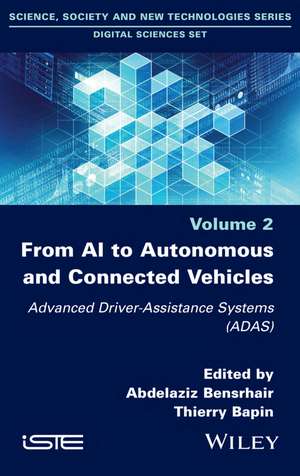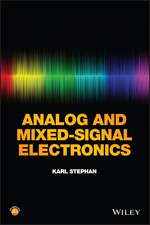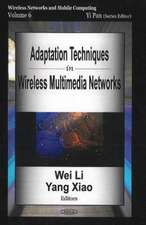From AI to Autonomous and Connected Vehicles – Advanced Driver–Assistance Systems (ADAS)
Autor E Bensrhairen Limba Engleză Hardback – 18 oct 2021
Preț: 982.93 lei
Preț vechi: 1080.14 lei
-9% Nou
Puncte Express: 1474
Preț estimativ în valută:
188.11€ • 204.26$ • 158.01£
188.11€ • 204.26$ • 158.01£
Carte tipărită la comandă
Livrare economică 23 aprilie-07 mai
Preluare comenzi: 021 569.72.76
Specificații
ISBN-13: 9781786307279
ISBN-10: 1786307278
Pagini: 288
Dimensiuni: 156 x 234 x 17 mm
Greutate: 0.58 kg
Editura: ISTE Ltd.
Locul publicării:Hoboken, United States
ISBN-10: 1786307278
Pagini: 288
Dimensiuni: 156 x 234 x 17 mm
Greutate: 0.58 kg
Editura: ISTE Ltd.
Locul publicării:Hoboken, United States
Cuprins
Foreword 1 xi
Thierry BAPIN
Foreword 2 xiii
Dominique GRUYER
Foreword 3 xix
Alberto BROGGI
Preface xxi
Abdelaziz BENSRHAIR
Chapter 1. Artificial Intelligence for Vehicles 1
Gérard YAHIAOUI
1.1. What is AI? 1
1.2. The main methods of AI 3
1.2.1. Deep Learning 3
1.2.2. Machine Learning 4
1.2.3. Clustering 5
1.2.4. Reinforcement learning 6
1.2.5. Case-based reasoning 8
1.2.6. Logical reasoning 8
1.2.7. Multi-agent systems 8
1.2.8. PAC learning 9
1.3. Modern AI challenges for the industry 9
1.3.1. Explainability: XAI (eXplainable Artificial Intelligence) 9
1.3.2. The design of so-called "hybrid" AI systems 10
1.4. What is an "intelligent" vehicle? 10
1.4.1. ADAS 11
1.4.2. The autonomous vehicle 14
1.4.2. The construction of the intelligent vehicle's basic building blocks employing AI methods 18
1.5. References 21
Chapter 2. Conventional Vision or Not: A Selection of Low-level Algorithms 25
Fabien BONARDI, Samia BOUCHAFA, Hicham HADJ-ABDELKADER and Désiré SIDIBÉ
2.1. Introduction 25
2.2. Vision sensors 26
2.2.1. Conventional cameras 27
2.2.2. Emerging sensors 30
2.3. Vision algorithms 33
2.3.1. Choosing the type of information to be retrieved from the images 34
2.3.2. Estimation of ego-movement and localization 39
2.3.3. Detection of the navigable space by a dense approach 44
2.3.4. From the detection of 3D plans to visual odometry 58
2.3.5. Detection of obstacles through the compensation of ego-movement 62
2.3.6. Visual odometry 66
2.4. Conclusion 71
2.5. References 72
Chapter 3. Automated Driving, a Question of Trajectory Planning 79
Olivier ORFILA, Dominique GRUYER and Rémi SAINCT
3.1. Definition of planning 79
3.2. Trajectory planning: general characteristics 81
3.2.1. Variables 83
3.2.2. Constraints 83
3.2.3. Cost functions 83
3.2.4. Planning methodology 83
3.2.5. Co-pilot respecting legal traffic rules 88
3.2.6. Trajectory prediction for "ghost" objects and vehicles 92
3.2.7. Trajectory evaluation 100
3.2.8. Results on real vehicles and on simulators 101
3.3. Multi-objective trajectory planning 104
3.3.1. Linear scalarization 107
3.3.2. Nonlinear scalarization 114
3.3.3. Ideal methods 116
3.3.4. Summary of multi-objective planning methods 119
3.3.5. High level information 119
3.4. Conclusion on multi-agent planning for a fleet of vehicles: the future of planning 121
3.5. References 122
Chapter 4. From Virtual to Real, How to Prototype, Test, Evaluate and Validate ADAS for the Automated and Connected Vehicle? 125
Dominique GRUYER, Serge LAVERDURE, Jean-Sébastien BERTHY, Philippe DESOUZA and Mokrane HADJ-BACHIR
4.1. Context and goals 125
4.2. Generic dynamic and distributed architecture 128
4.2.1. Introduction 128
4.2.2. An interoperable platform 129
4.3. Environment and climatic conditions 132
4.3.1. Introduction 132
4.3.2. Environmental modeling: lights, shadows, materials and textures 132
4.3.3. Degraded, adverse and climatic conditions 136
4.3.4. Visibility layers and ground truths 140
4.4. Modeling of perception sensors 143
4.4.1. Typology of sensor technologies 143
4.4.2. From a functional model to a physical model 145
4.4.3. Optical sensors 145
4.4.4. LIght Detection And Ranging (LIDAR) 149
4.4.5. RAdio Detection And Ranging (RADAR) 151
4.4.6. Global Navigation Satellite System (GNSS) 153
4.5. Connectivity and means of communication 157
4.5.1. State of the art 157
4.5.2. Statistical model of the propagation channel 158
4.5.3. Multi-platform physico-realistic model 159
4.6. Some relevant use cases 161
4.6.1. Graphic resources 161
4.6.2. Communication and overall risk 161
4.6.3. Automated parking maneuver 166
4.6.4. Co-pilot and automated driving 169
4.6.5. Eco-mobility and eco-responsible driving profile 171
4.7. Conclusion and perspectives 174
4.8. References 176
Chapter 5. Standards for Cooperative Intelligent Transport Systems (C-ITS) 181
Thierry ERNST
5.1. Context and goals 182
5.1.1. Intelligent transport systems (ITS) 182
5.1.2. The connected and cooperative vehicle 184
5.1.3. Silos communication systems 185
5.1.4. Cooperative Intelligent Transport Systems (C-ITS) 186
5.1.5. Diversity of Cooperative ITS services 186
5.1.6. Standardization bodies 189
5.1.7. Genesis of the "Cooperative ITS" standards 190
5.2. "ITS station" architecture 192
5.2.1. General description 192
5.2.2. ITS station communication units 195
5.2.3. Types of ITS stations 195
5.3. Features of the ITS station architecture 197
5.3.1. Combination of communication technologies 197
5.3.2. Centralized communications 198
5.3.3. Localized communications (V2X) 198
5.3.4. Hybrid communications 200
5.3.5. Extensive communications 202
5.3.6. Communications management 203
5.3.7. Messaging 204
5.3.8. Data organization and identification 206
5.3.9. Secure communications and access to data 207
5.3.10. Evolution of standards 208
5.4. Features of the ITS station architecture 208
5.5. Deployment of Cooperative ITS services 209
5.6. References 213
Chapter 6. The Integration of Pedestrian Orientation for the Benefit of ADAS: A Moroccan Case Study 215
Aouatif AMINE, Abdelaziz BENSRHAIR, Safaa DAFRALLAH and Stéphane MOUSSET
6.1. Introduction 215
6.2. Advanced Driver Assistance System (ADAS) 218
6.3. Proposal for an applicable system to the Moroccan case 219
6.4. General conclusion 230
6.5. References 231
Chapter 7. Autonomous Vehicle: What Legal Issues? 233
Axelle OFFROY
7.1. Introduction 233
7.2. The definition of the so-called "autonomous" vehicle 234
7.3. Legal framework and experiments 236
7.4. The notion of the "driver" 237
7.5. The notion of the "custodian" 238
7.6. What liability regime? 238
7.7. Self-driving vehicle insurance? 240
7.8. Personal data and the autonomous vehicle 242
7.9. The need for uniform regulation 245
List of Authors 247
Index 249













